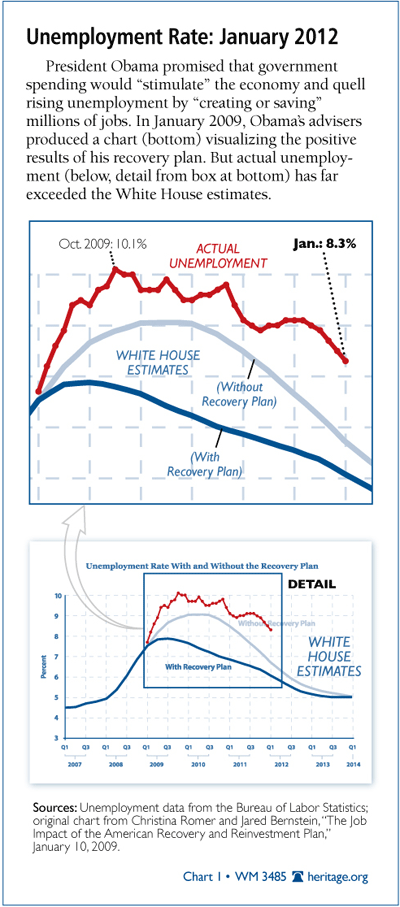The Bureau of Labor Statistics reported that in January, the economy added 243,000 jobs—108,000 more than the consensus forecast of 135,000. As a result, the unemployment rate fell from 8.5 percent to 8.3 percent, the lowest level since February 2009. For the last three months, job creation has averaged 201,000 a month, a sign that the labor market recovery may be truly underway.
Unfortunately, many fiscal policies enacted by Congress have generated little job growth. A two-month extension of the payroll tax cut does little to create employment, because the duration of the tax change is seen as temporary. Even worse, businesses have the added uncertainty of the expiration of the 2001 and 2003 tax cuts, which will constrain hiring.
The January Report
The American labor market had a strong month in January. The unemployment rate fell from 8.5 percent to 8.3 percent as many Americans were able to find work. The unemployment rate for adult men fell to 7.7 percent, the first time it has been under 8 percent since January 2011. This matches the unemployment rate of women, which fell from 7.9 to 7.7 percent.

The establishment survey had very good news, with 243,000 new jobs being created and upwards revisions of 60,000 for the two previous months. The number of hours worked also increased from 33.7 to 33.8 hours, and wages increased by 2 cents an hour. This is solid evidence of a strengthening labor market as more workers were added and existing workers worked more.
Private-sector job growth was 257,000 and was widespread. Manufacturing (50,000) and construction (21,000) had solid growth for the second straight month. The service sector (176,000) was led by professional business services (70,000) and health care (29,700). Temporary services (20,100) had a solid month. Government (–14,000) shed jobs mostly at the local level (–11,000) and federal level (–6,000).
Dropping Out of the Labor Force
The jobs report does contain some disturbing news: The labor force participation rate shows no sign of improving. Revisions to the population estimates show that only 63.7 percent of adult Americans are active in the labor force (either employed or looking for a job). This is the lowest since 1983, a time when far fewer women worked.
This is a worrying trend. Demographic factors caused labor force participation to peak in 2000 and gradually decline—as the baby boomers aged and started to retire, their labor force participation fell. Since the recession began, however, participation rates plunged by 2.3 percentage points—a drop that demographic factors do not explain.[1]

This phenomenon reduces the measured unemployment rate, because individuals who are not looking for work do not count as unemployed. The Congressional Budget Office (CBO) estimates that the unemployment rate would be 1.25 points higher if labor force participation had not unexpectedly declined.[2] CBO estimates that while the participation rate will stabilize in the near future, it will continue to decline as boomers retire. The unemployment rate does not reflect this labor market weakness.
Impact of Uncertainty
The January report gives hope that the long-awaited labor market recovery is well underway. Unfortunately, many fiscal decisions in Washington have been made that have not helped the labor market. In December, Congress extended a reduction in the payroll tax for two months as a way to stimulate job growth. A one-year extension, much less a two-month extension, does nothing for job growth, as companies are forward-looking. There is evidence that companies are more concerned about the looming expiration of the 2001 and 2003 tax bills instead of yet another short-term tax measure. Temporary tax cuts do little to increase economic growth instead of more permanent tax measures.
Researchers regularly ask small businesses what the single greatest problem they face is. In January, almost twice as many said the tax or regulatory burden (41 percent) as did poor sales (23 percent).[3] Congress can do little to improve business sales, but it directly controls taxes and regulations. Congress can encourage businesses to expand and hire by creating a favorable business climate. Congress should not raise taxes—especially not on entrepreneurs—and should streamline or eliminate unnecessary regulations.
A Steady but Weak Recovery
The January report is one of the strongest reports since last spring. Even better news is that there is now a three-month trend of job growth exceeding 150,000 jobs. It looks like the labor market recovery is strengthening. Unfortunately, the recovery is still too weak for where it should be in this business cycle. Congress should make permanent the 2001 and 2003 tax cuts as a way to bolster hiring and economic growth.
Rea S. Hederman, Jr. , is Assistant Director of and Research Fellow in the Center for Data Analysis, and James Sherk is Senior Policy Analyst in Labor Economics in the Center, at The Heritage Foundation.


